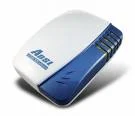
Asymmetric Digital Subscriber Line (ADSL) is a form of DSL, a data communications technology that enables faster data transmission over copper telephone lines than a conventional voiceband modem can provide. It does this by utilizing frequencies that are not used by a voice telephone call. A splitter - or microfilter - allows a single telephone connection to be used for both ADSL service and voice calls at the same time. Because phone lines vary in quality and were not originally engineered with DSL in mind, it can generally only be used over short distances, typically less than 4km [William Stallings' book].
At the telephone exchange the line generally terminates at a DSLAM where another frequency splitter separates the voice band signal for the conventional phone network. Data carried by the ADSL is typically routed over the telephone company's data network and eventually reaches a conventional internet network. In the UK under British Telecom the data network in question is its ATM network which in turn sends it to its IP network IP Colossus.
The distinguishing characteristic of ADSL over other forms of DSL is that the volume of data flow is greater in one direction than the other, i.e. it is asymmetric. Providers usually market ADSL as a service for consumers to connect to the Internet in a relatively passive mode: able to use the higher speed direction for the "download" from the Internet but not needing to run servers that would require high speed in the other direction.
There are both technical and marketing reasons why ADSL is in many places the most common type offered to home users. On the technical side, there is likely to be more crosstalk from other circuits at the DSLAM end (where the wires from many local loops are close to each other) than at the customer premises. Thus the upload signal is weakest at the noisiest part of the local loop, while the download signal is strongest at the noisiest part of the local loop. It therefore makes technical sense to have the DSLAM transmit at a higher bit rate than does the modem on the customer end. Since the typical home user in fact does prefer a higher download speed, the telephone companies chose to make a virtue out of necessity, hence ADSL. On the marketing side, limiting upload speeds limits the attractiveness of this service to business customers, often causing them to purchase higher cost Digital Signal 1 services instead. In this fashion, it segments the digital communications market between business and home users.
Currently, most ADSL communication is full duplex. Full duplex ADSL communication is usually achieved on a wire pair by either frequency division duplex (FDD), echo canceling duplex (ECD), or time division duplexing (TDD). FDM uses two separate frequency bands, referred to as the upstream and downstream bands. The upstream band is used for communication from the end user to the telephone central office. The downstream band is used for communicating from the central office to the end user.
Frequency plan for ADSL. The red area is the frequency range used by normal voice telephony (PSTN), the green (upstream) and blue (downstream) areas are used for ADSL.
Frequency plan for ADSL. The red area is the frequency range used by normal voice telephony (PSTN), the green (upstream) and blue (downstream) areas are used for ADSL.
With standard ADSL (annex A), the band from 25.875 kHz to 138 kHz is used for upstream communication, while 138 kHz – 1104 kHz is used for downstream communication. Each of these is further divided into smaller frequency channels of 4.3125 kHz. During initial training, the ADSL modem tests which of the available channels have an acceptable signal-to-noise ratio. The distance from the telephone exchange, noise on the copper wire, or interference from AM radio stations may introduce errors on some frequencies. By keeping the channels small, a high error rate on one frequency thus need not render the line unusable: the channel will not be used, merely resulting in reduced throughput on an otherwise functional ADSL connection.
Vendors may support usage of higher frequencies as a proprietary extension to the standard. However, this requires matching vendor-supplied equipment on both ends of the line, and will likely result in crosstalk issues that affect other lines in the same bundle.
There is a direct relationship between the number of channels available and the throughput capacity of the ADSL connection. The exact data capacity per channel depends on the modulation method used.
Modulation
ADSL initially existed in two flavours (similar to VDSL), namely CAP and DMT. CAP was the de facto standard for ADSL deployments up until 1996, deployed in 90 percent of ADSL installs at the time. However, DMT was chosen for the first ITU-T ADSL standards, G.992.1 and G.992.2 (also called G.dmt and G.lite respectively). Therefore all modern installations of ADSL are based on the DMT modulation scheme.
source: wikipedia.org

Post a Comment